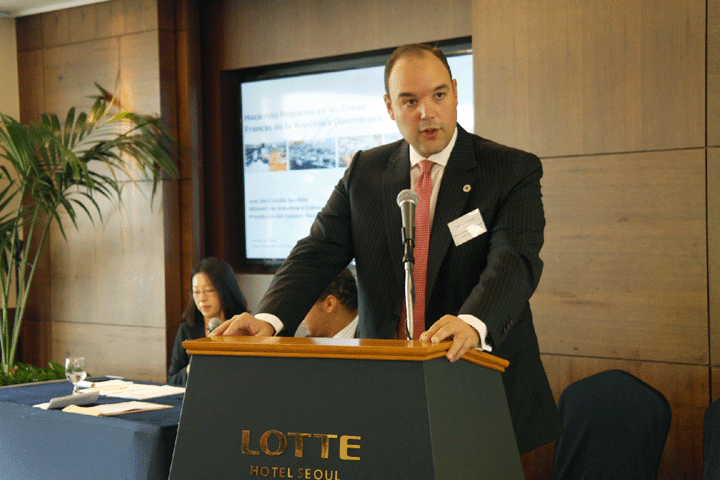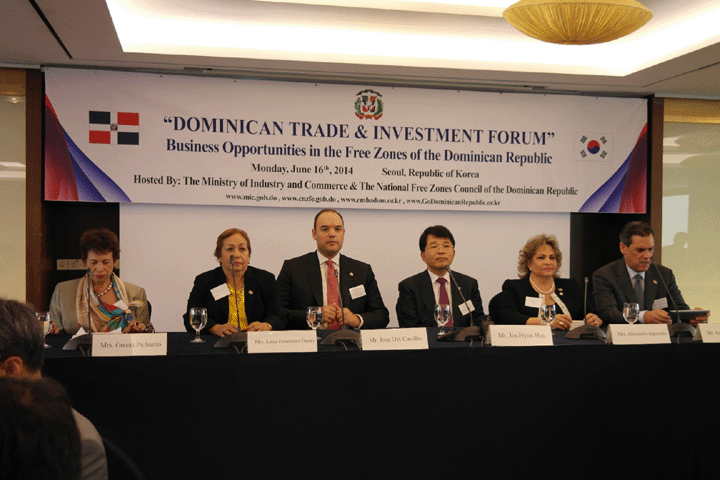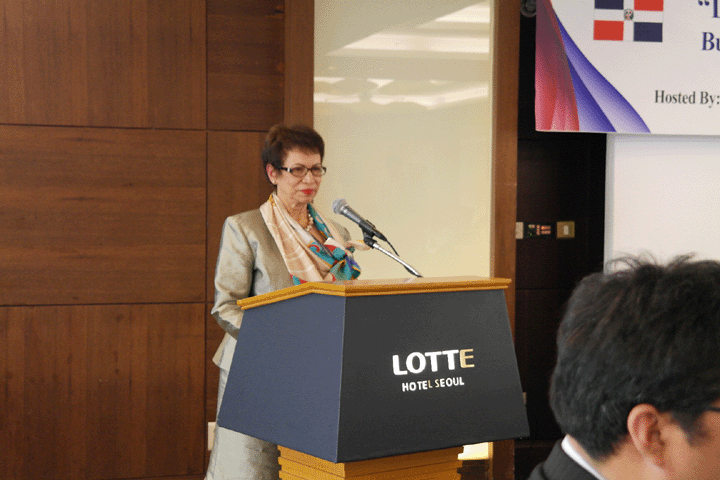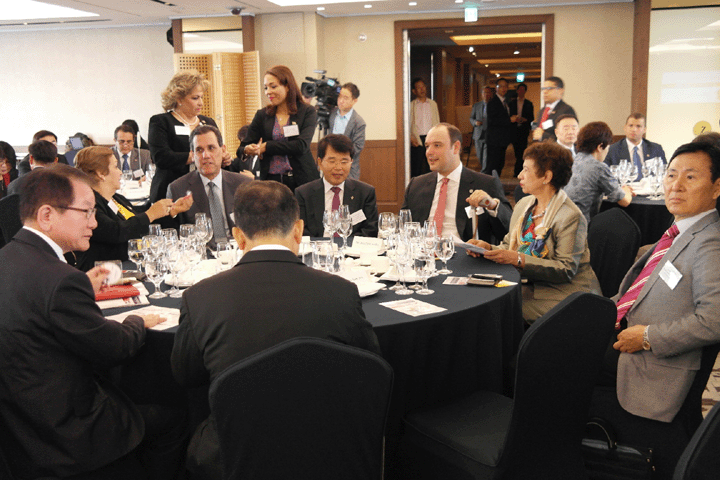Attended by Industry-Commerce Minister Castillo of DR
Minister of Industry & Commerce Jose Del Castillo of the Dominican Republic (DR) and Ambassador Grecia Fiordalicia Pichardo of the country hosted a “Dominican Trade & Investment Forum” at Lotte Hotel in Seoul on June 16, 2014 to introduce the business opportunities in the Free Zones of the country.
An estimated total of 150 Korean business leaders as well government representatives attended the Forum and had an interesting exchange of views and discussions with the 17 members of the trade delegation of the Dominican Republic.
Speaking in a welcome speech at the meeting, Ambassador Pichardor of the Dominican Republic said, “This Forum’s key objective is to present to the relevant Korean enterprises and businessmen all the advantages and incentives offered by the Free Zones of the Dominican Republic for the processing, manufacturing and outsourcing of their products and services.”
Then she said that the event was the first of its kind to be organized by the Dominican Embassy in Korea and that it constituted a unique opportunity for Korean businessmen to receive an earnest diagnosis of the country’s capabilities and strengths with regards to other countries in the region and worldwide.
“It also gives them an opportunity,” she said, “to have an open dialogue with the decision makers and key players of our country, about any possible concerns regarding issues like competitiveness, security, production costs and returns, and also to reach agreements in order to upgrade any aspects that, from their personal or corporative perspective, can be improved to insure Korean investors that they can develop successful, productive and sustainable businesses in our Country.” (See excerpts from the speech of Ambassador Pichardo towards the end of this Article.)
The Korean attendees at the Forum included Vice Minister Han Jin-Hyun of Trade, Industry & Energy; Director Seo Won-Sam for Central America & the Caribbean Affairs Bureau of the Ministry of Foreign Affairs; former Korean Ambassadors to the Dominican Park Dong-Sil and Kang Sung-Su; and Korean Honorary Consul Jun Byung-Hyun of the Dominican Republic.

Attending Forum from the Dominican Republic were Minister of Industry & Commerce Jose Del Castillo of the Dominican Republic, Ambassador Grecia Fiordalicia Pichardo, Executive Director Mrs. Luisa Fernandez Duran of the National Council of Free Zones, Director General Mrs. Alexandra Izquierdo of the Center for Industrial Development & Competitiveness, Promotion Manager Mrs. Silvia Coch?n of the Free Zones Council and other officials of the Council, including Promotion Coordinator Mrs. Yarisol L?pez, Economic Analyst and Competitiveness Officer Ebell De Castro and Industrial Linkage Officer Francisco Dominguez.
Following the welcome speech of Ambassador Pichardo, Minister of Industry & Commerce Jose Del Castillo of the Dominican Republic gave a keynote speech on the topic of “Doing Business in the Free Zones of the Dominican Republic.” He said, “Recently, a Report prepared by Stratford Global Intelligence with the title: ‘The Post-China 16,’ has designated the Dominican Republic as one of the 16 emerging economies that together will assume the role of China as the ‘factory of the world.’ This forecast is based in the evidence of a new Chinese economic model focused in the internal market, rising manufacturing costs, appreciation of the Yuan, labor shortage, an many other factors.”
“However,” he said, “the inclusion of the Dominican Republic in this group is not a random event. It is the result of the solid competitive advantages that our country has developed in recent years.” (See excerpts from the keynote speech at the end of this Article.)
Excerpts from the speech of Ambassador Pichardo:First of all, allow me to express, on behalf of the Dominican people and Government, our deepest gratitude, to each and every single one of you, for being here with us today, in this landmark event, aimed at consolidating even further the bonds of trade and cooperation between the Dominican Republic and the Republic of Korea.
I would also like to thank the Embassy’s staff and the staff of the NCFZ, which have worked very hard to put this event together; and, very specially, we would like to express our sincere appreciation for the unyielding support and contributions made by Mr. Jun Byung-Hyun, Honorary Consul of the D.R. in Seoul.
We feel very fortunate to have an official delegation composed of such prominent and successful business leaders from the Dominican Republic, who through their presentations and during the match making session will offer you an in-depth view of our country’s favorable investment environment and extraordinary potential.
As Diplomats, we are used to lengthy speeches, but today our audience is mostly composed by businessmen, so I will keep my words short and sweet.
Recently, I was interviewed by a journalist, who asked me if I could briefly explain the objective of this Forum, and I would like to share my answer with all of you:
Quote
“The Forum’s key objective is to present to relevant Korean enterprises and businessmen, all the advantages and incentives offered by the Free Zones of the Dominican Republic, for the processing, manufacturing and outsourcing of their products and services.
The event is the first of its kind to be organized by the Dominican Embassy in Korea, and it constitutes a unique opportunity for Korean businessmen to receive an earnest diagnosis of the country’s capabilities and strengths with regards to other countries in the region and worldwide. It also gives them an opportunity to have an open dialogue with decision makers and key players of our country, about any possible concerns regarding issues like competitiveness, security, production costs and returns, and also to reach agreements in order to upgrade any aspects that, from their personal or corporative perspective, can be improved to insure Korean investors that they can develop successful, productive and sustainable businesses in our Country.”
End of quote
In recent times, the world seems to have become virtually flat and relatively smaller, due to the incredible advances in information and communication technologies. However, diplomatic work is still a very personal affair. Just like those who connect the world through the web and the internet, Diplomats are engineers who build bridges between nations and people. The dynamics of individual interaction and personal exchanges, that can be achieved by actively participating in this Forum, are vital is to make these bridges stronger and bring our nations even closer together, by increasing mutual understanding and forging solid and long lasting partnerships.

Ladies and gentlemen, once again, I’m extremely joyful to have you all here today, and let’s work together with enthusiasm and faith; our joint efforts will certainly bring wealth and prosperity to our people and will strengthen the ties of friendship and cooperation between our countries.
Thank you very much, Muchas Gracias, Kam-Sa Ham- Ni- Da.
Excerpts from the keynote speech by Minister Jose Del Castillo:
Good morning everybody, it is a tremendous pleasure to be here with you all for presenting the remarkable opportunities that the Free Zones of the Dominican Republic are offering.
We have a very quick presentation. I will show you first the overall performance of the free zones of the Dominican Republic, including the elements that make us believe that it is indeed an excellent platform for manufacturing and services outsourcing to compete in the global market.
Secondly, we will explore the basic structure of the free zones in the Dominican Republic, considering as well its leaderships among other export industries; and its positioning in the international market, including its capacity for attracting Foreign Direct Investment. Afterwards, we will explore the attributes and competitive advantages that make the Dominican Republic one of the best countries for doing business.
First, before going into the details of the free zones system in the Dominican Republic, it is my duty to give you an overview of my country (en pr?ximo slide)
The Dominican Republic occupies two-thirds of “La Hispaniola” island, in its eastern side, located between the Caribbean Sea and the North Atlantic Ocean, as part of the Greater Antilles in the Caribbean region. Both by area and population, the Dominican Republic is the second largest Caribbean nation, after Cuba. As well, with a Gross Domestic Product (GDP) of sixty-one point three billion, the International Monetary Fund classified the Dominican Republic as the seventh largest economy in Latin America.
Traditionally, our country has been known as a major touristic destination, and this is understandable since the DR is the sixth most visited country in the western hemisphere, receiving around 5 million tourists attracted by the beautiful natural resources, rich culture and history, entertainment and sports.
However, the Dominican Republic also hosts one of the most important manufacturing industries in the Region, with solid connections to the international markets, which have been possible at great extent to the free zones platform that the country has developed.
A Free Zone is defined by Dominican Law as “A geographic area of the country under special customs and tax controls, in which enterprises will be licensed to devote their production of goods or services to foreign markets through the granting of incentives to stimulate their development.” However, our history, experience and success in the free zones development is not new.
The Industrial Free Zones began their development in the Dominican Republic in 1969, attracting foreign direct investment projects to the country during the last 45 years.
This map shows very clearly the strong distribution of free zones across the country. Every red or blue small dot in the map represents an industrial park or a special free zone, which is basically a free zone company operating outside an industrial park.

Throughout the years the free zone model in the Dominican Republic has changed and evolved. Back in 1975 it was only labor intensive with a concentration in light manufacturing. Since 2003 onward, the new model has applied complex technologies into the production process, including vertical integration and manufacturing of intermediate goods, while many companies apply their own “in-house” design and development activities.
These are signs that we have been able to adapt and grow with the changing needs of manufacturers around the world.
The Free zones have granted the Dominican Republic the leadership in several product categories in the global market, and specifically in the USA. Currently, we are the first worldwide exporter of cigars; the second most important supplier of circuit breakers to the USA; the third exporter of medical devices in Latin-American, and fifth US supplier; and the fifth major exporter of leather footwear to the biggest market in the world.
As well, other products like dental floss, cotton underwear and woolen coats are among the top exports of our country and hold significant positions at a global level.
However, our regional leadership can be found as well in the services sub-sector, where according to “The Caribbean and Central America Contac Center/BPO Report 2012”, the Dominican Republic is not only the most competitive country in the region in terms of taxes, labor, real estate, transportation and security; It also has been ranked first in number of agents, companies and revenues.
Furthermore, in the past five years, the overall economic and social performance of the free zones has been outstanding. The figures experienced by the sector during the year 2013, showed that beyond a recovery process, we are witnessing the consolidation and strengthening of this sector.
In terms of jobs, last year we registered one hundred forty four thousand three hundred eighty three direct jobs, and more than two hundred thousand indirect jobs, with a growth of twenty four percent in this period.
As well, exports reached a new record, rising for the first time in history the threshold of five billion dollars, and occupying fifty two percent of total exports. At the same time, we registered an increase of almost twenty six percent in total investments in the sector, reaching the amount of 3.4 billion dollars, which by the way, fifty one percent of this assets belong to US companies.
It is important to note the behavior of the sub-sectors that have motorized the growth of free zones over the past five years. First, we have the footwear subsector with a growth of one hundred nine percent in the period 2009-2013. It is estimated that in the next five years, footwear exports will multiply by four. Other sub-sectors with a strong share in the overall growth of free zones exports include: cigars and tobacco; medical products, and textiles and apparel.
On the other hand, it should be noted the recent growth trend in the services subsector, mainly led by the establishment of companies such as: contact centers, data processing centers, and professional services. In 2004, services companies accounted for almost nine percent of all companies in free zones. In 2013, these companies increase their share to twenty percent, employing approximately fifteen percent of all workers in the free zones. During the mentioned period, jobs in services increased two hundred and sixty three percent.

In this slide, you would see some of the companies that have trusted the Free Zones of the Dominican Republic for manufacturing and Services operations.
We believe that there are several advantages that make the Dominican Republic one of the most attractive destinations to Foreign Investor. However, there are some new elements that maximize the attractiveness of the country.
Recently, a Report prepared by Stratford Global Intelligence with the title: “The Post-China 16”, has designated the Dominican Republic as one of the 16 emerging economies that together will assume the role of China as the “factory of the world”. This forecast is based in the evidence of a new Chinese economic model focused in the internal market, rising manufacturing costs, appreciation of the Yuan, labor shortage, an many other factors.
However, the inclusion of the Dominican Republic in this group is not a random event. It is the result of the solid competitive advantages that our country has developed in recent years.
Our first advantage, and one of the most important, is the Political and Economic Stability. Indeed, the Dominican Republic has enjoyed over 50 years of continued democracy and peace.
Furthermore, the Marsh-Maplecroft 2014 report places us among the developing countries with lower political risk.
Our GDP and FDI have been constantly growing in pass years.
Moreover, according to the Economic Commission for Latin America and the Caribbean (ECLAC), in 2012 the DR was the top recipient of FDI inflows in the Central America and Caribbean Region, leading as well inflows to the region from 2000-2012.
The Dominican Republic boasts a favorable legal Framework and Incentives for international market Access.
We currently have Free Trade Agreements with more than fifty (50) countries, having preferential access to more than 1 billion of consumers around the world.
These agreements have established very flexible rules of Origin for several products and services, creating a competitive framework for the attraction of investments.
Another great asset of the country for attracting foreign investor, is the Free Zone law that provides all free zone companies with 100% exemption on the payment of basically all national/local taxes, including:
Corporate Income Tax;
Sales tax;
Tariff and Import Duties;
Construction, Loans, and Real Property Transfer Tax;
Export and Re-Export Tax;
Property, Assets and Patent Tax;
Municipal and Local Taxes;
Furthermore, the Free Zone Law grants many other incentives that go beyond tax exemptions, including: simplified customs procedures, with a special Customs Deputy Director for Free Zone operation; and a special Program that provides funding and operative structure for assisting firms with training programs.
Another important legal framework is Law 56-07 declaring textile, apparel, leather and footwear local industries as a National priority, granting similar incentives to those provided by the Free Zone Law.

As we mentioned at the beginning, the DR has the second largest population in the Central America and Caribbean Region, but most importantly, forty seven percent (47%) of the population is under 24 years old, so we can affirmed that our future is ensured.
Free Zones companies in the Dominican Republic also enjoy from one of the most competitive wages in the Americas, and especially in the Mexico, Central America and Caribbean Region, which hosts an important US supplier base. As you may see in this chart, DR minimum wage (currently one hundred sixty seven dollars) is bellow wages in strong competitor countries like China, and other important US regional suppliers like El Salvador, Guatemala and Honduras.
Fringe benefits paid by the employer represents thirty one percent of the nominal salary.
In the case of manufacturing activities, this chart shows how wages have been notably stable, evidencing a yearly average growth of 3.5 percent. This is especially relevant when compared to other countries like China, where average hourly wage in apparel and footwear manufacturing for example, is growing annually above fifteen percent (15%)
The Dominican Republic also exhibits a broad and modern network of transport infrastructure, eleven (11) ports, nine (9) International Airports, and more than 19,000 kilometers of roads. Actually, the most recent Global competitiveness Report, ranked the Dominican Republic second in Quality of Ports and Air Transport Infrastructure within the Mexico and Central America Region.
As well, the country has fifty five (55) Free Zone Industrial Parks offering world class facilities, services and competitive prices.
Fortunately, mother nature provided our country with an extraordinary geographic location, right in the middle of the Americas, and just a couple of hours away from the biggest market in the world. Thanks to our privileged location, the country has developed this modern and efficient infrastructure that has allowed a broad range of international transport services.
Currently, the DR receives approximately eighty (80) weekly ships, with direct routes to North and Central America, Europe, The Caribbean, Asia and South America, and more than sixty (60) daily flights, with strong connectivity to North and Central America, and Europe.
Maybe one of the biggest advantages of investing in the Dominican Republic is the fact that the free zones are supported by the government at the highest level. There, we have to highlight the role of the National Free Zones Council of the Dominican Republic as the governmental (public-private) regulatory agency in charge of promoting, evaluating, and assisting all free zones in the country, and has done so for over 30 years.
This institution provides first-level attention to current and potential investors, with a direct link to the Office of the President of the Dominican Republic.
Moreover, the Center for International Development at Harvard University has also praised The National Free Zones Council for “their Broad-band System, which maintains a constant dialogue with operating companies and potential investors, identifying barriers to investment and the requirements of public goods necessary for productivity improvements, while demanding for different government agencies troubleshooting and the provision of identified public inputs”
For all these reasons, my friends, we believe that the Dominican Republic will continue developing its leadership and potential for attracting FDI, while constructing the best environment for doing business in our region.
Finally, I would like to invite you all to visit our country to experience in the field the advantages and opportunities provided by the free zone system.

